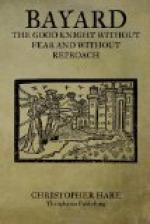Meantime, by permission of the King, Messire Claude de Vauldray had caused it to be published and declared throughout the city that he would hold the “pas” against all comers, both on foot and on horseback, on the approaching Monday.
A tournament was always a gorgeous and brilliant spectacle, but on this occasion, being held by the King’s desire and graced by his presence, it was more splendid than usual. In our day, when it is the custom of men to avoid all show and colour in their dress, we can scarcely picture to ourselves the magnificence of those knights of the Renaissance. When the gallant gentleman actually entered the lists for fighting, he wore his suit of polished armour, often inlaid with gold or silver, a coloured silken scarf across his shoulders richly embroidered with his device, and on his head a shining helmet with a great tuft of flowing plumes. But in the endless stately ceremonies which followed or preceded the tournament, the knight wore his doublet of fine cloth, overlaid with his coat-of-arms embroidered in silk or gold thread, and an outer surcoat of velvet, often crimson slashed with white or violet satin, made without sleeves if worn over the cuirass and finished with a short fluted skirt of velvet. Over this a short cloak of velvet or satin, even sometimes of cloth of gold, was worn lightly over one shoulder.
If this was the usual style of costume, which had also to be varied on different festivals, we can easily understand how impossible it was for young Bayard to procure such costly luxuries on his small means, and we can almost forgive him for the audacious trick he played on his rich relation the Abbe of Ainay. Not only was the knight himself richly clad, but we are told that to appear in a grand tournament even the horse had to have sumptuous trappings of velvet or satin made by the tailor. We have not mentioned the suit of armour, which was the most expensive item of all; being made at this period lighter and more elaborate, with its flexible over-lying plates of thin, tempered steel, it was far more costly than it had ever been before. The bravest knights at the Court were proud to try their fortune against Messire Claude. It was the rule that after the contest each champion was to ride the whole length of the lists, with his visor raised and his face uncovered, that it might be known who had done well or ill. Bayard, who was scarcely eighteen and had not done growing, was by nature somewhat thin and pale, and had by no means reached his full strength. But with splendid courage and gallant spirit, he went in for his first ordeal against one of the finest warriors in the world. The old chronicler cannot tell how it happened, whether by the special grace of God or whether Messire Claude took delight in the brave boy, but it so fell out that no man did better in the lists, either on foot or on horseback, than young Bayard, and when it came to his turn to ride down with his face uncovered, the ladies of Lyons openly praised him as the finest champion of all. He also won golden opinions of all the rest of the company, and King Charles exclaimed at supper:




